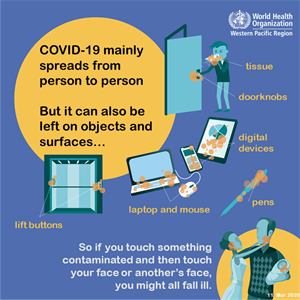




LINKS
World Health organisation:
Vaccine information:
Australian government:
State health departments:
For employers:
For health professionals:
COVID-19 INFORMATION
advice for the elderly
Elderly people are particularly at risk of COVID-19. Here is some advice for the elderly on how to reduce their risk of infection from SARS-CoV-2. A number of translations are provided for you to distribute more widely.
HOT TOPIC in Microbiology Australia
The below edition of Microbiology Australia focuses on COVID-19. Available online here.
Disease X ver1.0: COVID-19. The SARS-Cov2 has presented the world with a novel pandemic challenge requiring a rapid response. Professor Paul Young, a past ASM president, and part of a group working with urgency on Australia’s leading COVID-19 candidate vaccine, provides a current snapshot on their activities in Microbiology Australia. The group can also be found communicating on Twitter.
COVID-19: a novel zoonotic disease caused by a coronavirus from China: what we know and what we don’t. Read more in our latest article published on 17 March 2020 in Microbiology Australia.
An image of SARS-CoV-2, the virus responsible for COVID-19 disease. This image is a colorized transmission electron micrograph (TEM) and is work of the Australian Animal Health Laboratory (AAHL), CSIRO.
FAQ
What is COVID-19?
COVID-19 is a respiratory disease caused by a new type of coronavirus called SARS-CoV 2.
What are the symptoms?
Symptoms of COVID-19 may resemble the flu and include:
Fever
Coughing
Sore throat
Runny nose
Fatigue
Shortness of breath
How is it transmitted?
COVID-19 can be transmitted from person to person through small respiratory droplets generated during coughing or sneezing. The virus may also be transmitted through contact with contaminated surfaces.
Who is at risk?
Anyone can contract the disease, however most people will recover and the disease will be mild. The people most at risk of developing serious complications such as pneumonia are the elderly and those with pre-existing medical conditions.
Is there a vaccine for COVID-19?
When COVID-19 emerged there was no vaccine for the viral disease. However, scientists around the world have successfully developed a number of vaccines that are being rolled out.
Why can’t it be treated with antibiotics?
COVID-19 is a viral disease. Antibiotics only act on bacteria, not on viruses.
How do I reduce my risk of infection?
There are several ways we can reduce our risk of infection through good hygiene practices and social distancing:
Cover your mouth when coughing or sneezing with a clean tissue or your elbow. Avoid using your hand as you can contaminate surfaces or other people when you touch.
Regularly wash hands with warm soapy water for at least 20 seconds or use an alcohol-based hand sanitiser.
Wear a mask when in large group of peoples or in close proximity.
Where possible, maintain a distance of >1.5 metres with the people around you.
UPCOMING EVENTS
Please let us know via the email below or social media if your branch is holding any online events related to COVID-19.




